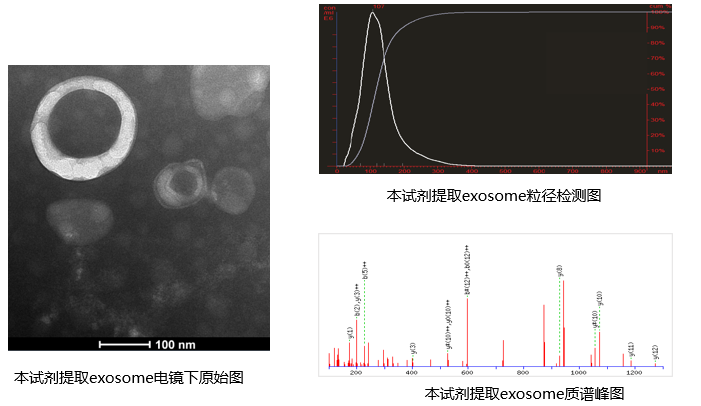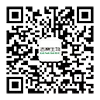- 產品
- ·
外泌體提取試劑盒
- 產品介紹
- 客戶文章
- 說明書下載
- Q&A

Exosome (外泌體)是體液中天然存在的、活細胞分泌的直徑約為30-150nm的納米級雙層囊泡小體,它攜帶有很多的遺傳物質和參與細胞活動調控的重要蛋白,可通過自分泌或旁分泌途徑被細胞吸收,也可經循環系統被遠距離靶組織或器官所吸收,能參與機體多種生理和病理過程。
近幾年外泌體研究的持續升溫,全球科研大咖紛紛扎堆此領域,有關外泌體載藥、診斷、免疫療法等方向的文章陸續發表在Science、Nature等各大頂級期刊上,外泌體已成為生命科學/基礎醫學研究的一大熱點。
外泌體廣泛的存在于體液中,如外周血、唾液、尿液、腹水、羊水、腦脊液等。然而,實驗中分離到讓人滿意的外泌體并不是容易的事!

產品優勢
1)操作簡單,使用方便,無需超速離心,比傳統方法省時省力。
2)高效分離,純度高,富集量大,應用范圍廣。
3)獲取的Exosome結構和功能完整。
4)可用于WB、ELISA、蛋白質譜、qPCR、測序等后續實驗。
5)穩定性好,便于運輸,便于保存。
性能展示

[1] IF8.579 Smooth muscle SIRT1 reprograms endothelial cells to suppress angiogenesis after ischemia. Theranostics
[2] IF8.079 Human umbilical cord mesenchymal stem cell-derived exosomal miR-335-5p attenuates the inflammation and tubular epithelial–myofibroblast transdifferentiation of renal tubular epithelial cells by reducing ADAM19 protein levels. Stem Cell Research & Therapy
[3] IF6.684 CircRNA_100395 Carried by Exosomes From Adipose-Derived Mesenchymal Stem Cells Inhibits the Malignant Transformation of Non-Small Cell Lung Carcinoma Through the miR-141-3p-LATS2 Axis. Frontiers in Cell and Developmental Biology
[4] IF6.543 Rat Bone Mesenchymal Stem Cell-Derived Exosomes Loaded with miR-494 Promoting Neurofilament Regeneration and Behavioral Function Recovery after Spinal Cord Injury. Oxidative Medicine and Cellular Longevity
[5] IF5.753 Exosomes secreted by chronic hepatitis B patients with PNALT and liver inflammation grade ≥ A2 promoted the progression of liver cancer by transferring miR-25-3p to inhibit the co-expression of TCF21 and HHIP. CELL PROLIFERATION
[6] IF5.249 TGF-β1-modified MSC-derived exosomal miR-135b attenuates cartilage injury via promoting M2 synovial macrophage polarization by targeting MAPK6. CELL AND TISSUE RESEARCH
[7] IF5.168 Characterization of the release and biological significance of cell-free DNA from breast cancer cell lines. Oncotarget
[8] IF4.627 YBX-1 mediated sorting of miR-133 into hypoxia/reoxygenation-induced EPC-derived exosomes to increase fibroblast angiogenesis and MEndoT. Stem Cell Research & Therapy
[9] IF4.219 The exosome-circ_0001359 derived from cigarette smoke exposed-prostate stromal cells promotes epithelial cells collagen deposition and primary ciliogenesis. TOXICOLOGY AND APPLIED PHARMACOLOGY
[10] IF3.743MiR-145 negatively regulates TGFBR2 signaling responsible for sepsis-induced acute lung injury. BIOMEDICINE & PHARMACOTHERAPY
[11] IF3.337 Exosomal-lncRNA DLEU1 Accelerates the Proliferation, Migration, and Invasion of Endometrial Carcinoma Cells by Regulating microRNA-E2F3. OncoTargets and Therapy
[12] IF3.304 TGF-β1 promoted chondrocyte proliferation by regulating Sp1 through MSC-exosomes derived miR-135b. CELL CYCLE
[13] IF2.967 Exosomes derived from HBV associated liver cancer promote chemoresistance by upregulating chaperone mediated autophagy. Oncology Letters
[14] IF2.759 MEG3 LncRNA from Exosomes Released from Cancer-Associated Fibroblasts Enhances Cisplatin Chemoresistance in SCLC via a MiR-15a-5p/CCNE1 Axis. YONSEI MEDICAL JOURNAL
[15] IF2.392 lncRNA-HEIH in serum and exosomes as a potential biomarker in the HCV-related hepatocellular carcinoma. Cancer Biomarkers
[16] IF1.62 miR-6718-5p and miR-4329 can be used as potential biomarkers for acute myocardial infarction. JOURNAL OF CARDIAC SURGERY
[17] IF1.313 The relationship between mouse lung adenocarcinoma at different stages and the expression level of exosomes in serum. Mathematical Biosciences and Engineering
[18] IF0.205 The exosome-mediated PI3k/Akt/mTOR signaling pathway in cervical cancer. International Journal of Clinical and Experimental Pathology
1.外泌體研究,應選用血漿還是血清?
血清是血液凝固之后收集的液體,所以其中少了纖維蛋白原,凝血因子,以及多了很多凝血產物。纖維蛋白原可轉化為纖維蛋白,具有凝血功能。在凝血過程中血小板會分泌大量的外泌體,有研究發現血清中有接近50%的外泌體來自額外的分泌。
血漿=血液-血細胞 血清=血漿-纖維蛋白原-凝血因子
所以一般實驗選擇血漿,在特殊情況下,如研究與血小板相關的疾病的時候,當然是血清更適合。
2.外泌體提取試劑提取外泌體一般后續檢測QPCR需要多少血漿呢?多少mL的血清或血漿提出來的外泌體夠同時做RNA測序和蛋白質譜的嗎?
1-2mL的血漿足夠后續的QPCR檢測;4mL的血清或血漿可滿足RNA測序和蛋白質譜的需求。
3.如何鑒定提取出來的外泌體?
根據國際細胞外囊泡協會于2014年發表的一個指導手冊(MISEV),鑒定外泌體首先需要通過WB來鑒定細胞外囊泡的標志蛋白是否存在于樣品中,通過電子顯微鏡來觀察樣品中細胞外囊泡的形態特征,通過NTA等手段來分析樣品中細胞外囊泡的群體特征(粒子濃度、直徑分布等)
4.提取出來的外泌體能否應用于細胞共培養?
我們提取出來的外泌體通過粒徑檢測能判斷其純度(粒徑大小均在外泌體的大小范圍),電鏡檢測能判斷其形態確為外泌體。如果樣品中的外泌體有活性的話是可以進行細胞共培養的實驗的。
5.外泌體如何保存?
純化完成后的外泌體可分裝成50-100uL后置于-80℃保存。
6.用吉賽的外泌體提取試劑盒從2mL血清血漿提取出來的外泌體能有多少?能滿足后續的電鏡和WB嗎?BCA方法測定的蛋白濃度是多少?
2mL血清血漿提取出來的外泌體數量約1*10的8次方-9次方,可以滿足。BCA方法測定的蛋白濃度為2~4ug/uL
7.外泌體電鏡是不是一定要有膜結構,無膜結構的球體對不對?
負染電鏡結果中外泌體的形態肯定是那種明顯的茶托樣或者大餅樣的!邊緣有一圈略微更明亮的亮圈。如果你打到的結構是沒有膜結構的圓球形,那么您很可能看到了脂蛋白顆粒或者抱團的蛋白質。
8.為什么超速離心提取外泌體看不到沉淀?
這種問題通常有三種可能性:
其一:使用的細胞上清或者血清量太低,從而造成了這樣的結果。
其二:使用了不透明的超速離心管,一般來說外泌體產量都比較小,所以凡是不透明的管子,基本都是很難見到明顯沉淀的,可以當做有沉淀,然后操作下去即可。
其三:使用了角轉。部分品牌離心機的角轉管壁粘附性很低,超離結束沒多久沉淀就會滑落下去,所以請在離心結束時趕緊去收樣。
填寫需求描述給我們
工具快速咨詢
400-8989-400
geneseed@geneseed.com.cn
- 返回頂部

 購物車
購物車





 廣州市黃埔區開源大道11號科技企業加速器A區6棟2樓
廣州市黃埔區開源大道11號科技企業加速器A區6棟2樓


 geneseed@geneseed.com.cn
geneseed@geneseed.com.cn